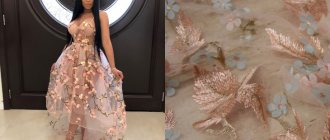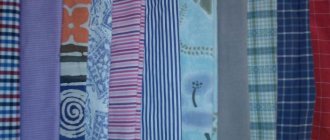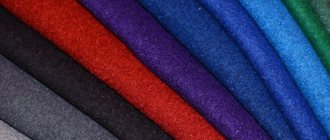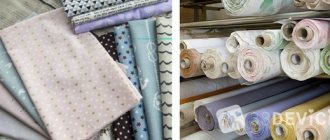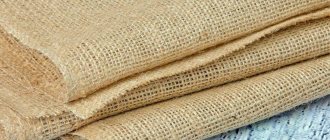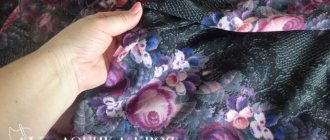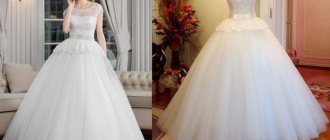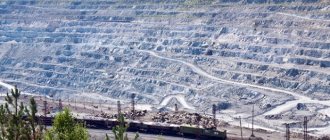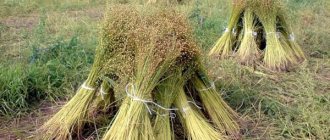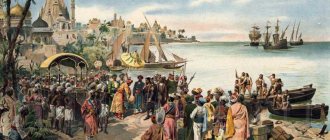The basis of the wardrobe is the dress. It emphasizes femininity, the dignity of the figure, creates comfort and decorates. Depending on the style, color and type, they wear it to work, walk, attend parties and special events.
Dress fabrics represent a group of materials that combine dense and light materials, warm and summery, flowing and shape-holding, natural and synthetic, for different occasions and seasons. The presented types of fabrics for dresses consist of natural and synthetic fibers, with and without stretch, with a decorative and matte surface, everyday, elegant and universal. A description of the properties and features of the fabric will help you make the right choice.
Flowing dense
Barbie
Barbie is a costume material for business wear. Characterized by softness and elasticity due to stretch fibers. The texture of the fabric is rough, dense and soft to the touch. The matte material is pleasant and comfortable to wear. It has a synthetic composition of polyester, viscose and spandex with the addition of elastane. Barbie fabric can be plain or patterned.
Crepe suit
A popular fabric for everyday and formal wear, as well as sheath dresses. It has a presentable appearance and positive performance characteristics. The fabric is dense, with the inherent crepe grain. Minimal give ensures good fit and comfortable wear. The fabric does not stretch and does not interfere with freedom of movement. Mostly a plain crepe suit is produced. Patterns and prints are less common. The composition includes natural and synthetic fibers: cotton, wool, polyester, acrylic and viscose.
Stretch velor
Stretch velor is a luxurious material. The material has a soft, fleecy surface with a sparkling shine. The dense structure of the fabric acquires elasticity due to stretch fibers. The material is pleasant to the touch and comfortable to wear. Gracefully fits the figure. It is presented on the market in a plain-painted version in a palette of shades. Suitable for evening and ball gowns, skirts and knee socks.
Gabardine
Gabardine is a dense, light and soft fabric that is resistant to deformation. Lacks elasticity except for the stretch version. It turns out to be a twill weave, which leaves a diagonal scar on the matte surface. The material is double-sided.
Available in wool gabardine, blended, cotton, silk, stretch and synthetic. Pleasant to wear and practical, the material is made in plain colors, checkered, or printed.
Lungs
Oil
The fabric belongs to modern knitted fabrics with a characteristic soft-oily structure. Made from viscose, lycra and polyester fibers in several combinations. The oil material is dense and flexible, elastically stretches in different directions and fits the figure well. Silky material can have a matte or glossy surface. The oil is comfortable to wear, has breathable properties and looks attractive.
Niagara
Refers to dress, flowing fabrics. Despite its fine structure, niagara is not translucent. It has a matte, smooth surface, pleasant to the touch. It stretches across the transverse thread, across the width of the fabric. It is made from viscose and polyester fibers with a plain or printed pattern. Does not wrinkle and drapes gracefully. Looks light and airy.
Poplin
Cotton-based material with the addition of polyester, silk or wool fibers. Produced with printed, variegated or smooth patterns. Poplin is soft and pleasant to wear. Provides air access to the skin and moisture absorption. Retains color saturation for a long time and does not wrinkle. Comfortable clothes for everyday wear are sewn from it.
Silk Armani
Modern material for a summer or elegant dress. Attracts with its silky surface with a matte shine. Consists of polyester fibers with a small addition of spandex (3%). The thin, slippery Armani silk fabric is made from satin weave and resembles silk. It has elasticity and wear resistance. Has low hygroscopicity and breathability. Requires the use of an antistatic agent. Looks impressive in models of dresses, skirts and loose-fitting blouses, with folds and draperies.
Chiffon
Very light, thin, transparent and airy chiffon has a matte surface and a sandy structure. Consists of natural silk or synthetic fibers. Externally, the fabric is quite durable. There are many varieties available: nylon, chiffon-satin, jacquard, with lurex, chameleon and shanzhan.
Used alone or in combination with companion fabrics. The ability flows softly, giving the image femininity and mystery.
Atlas
Satin is a smooth, silky material with a luxurious, glossy surface that shines and shimmers. Made from silk, cotton, synthetic, viscose and nylon fibers. It can be plain or with bright patterns applied with embroidery, embossing, and printing. The fabric is durable and wear-resistant, does not fade, is comfortable, and is suitable for draperies. Used for evening and wedding dresses, elegant clothes.
Crepe de Chine
The lightweight fabric has a matte sheen and a rough, wavy structure. Crepe de Chine is soft and pleasant to the skin. Smoothly follows the curves of the figure and forms graceful folds. Durable and comfortable to wear. Available in a wide palette of shades, patterns and prints as shown in the photo. Allows you to realize your fantasies in creating feminine silhouettes.
Staple
Soft and delicate fabric, elastic and easily takes the desired shape of the dress style. The silky, smooth surface, as well as the variety of colors, patterns and designs guarantee a luxurious look to the outfit. At the same time, it will be comfortable in the heat. Staple fabric is a natural material that includes viscose or cotton.
Georgette
Thin, twisted threads produce a translucent material. Georgette has a matte surface and a grainy, harsh texture. It is elastic and pliable, shape-resistant and effective. The material can be plain, with a printed pattern, designer trim, or sparkles. The fibers used for production are silk, polyester, viscose, cotton, and elastane.
Silk
The name of fabrics for royal dresses, luxurious and refined. It has a soft shine with shimmer, smoothness and lightness. Many types of silk fabrics are made, differing in structure, quality of threads, and appearance. They are all durable and extremely comfortable to wear. In textile production, silk is made from artificial fibers viscose and nylon, but nothing compares to natural silk, made from non-mulberry cocoons.
Types of fabrics by density
- Dense, drapeable
Barbie is suitable for office-style models - it is an elastic, soft, but dense material with a rough surface, matte, and wear-resistant. Suit crepe looks beautiful, especially when sewing a sheath-type model. The crepe does not deform, does not shrink when washed, it contains natural and synthetic fibers. Thick gabardine is lightweight, double-sided, and does not deform.
- Light and airy fabrics for dresses
Available in synthetic, artificial, mixed and natural versions.
Oil knitted fabric, which is named for its special structure, is popular. It flows beautifully, fits the figure, the surface is matte or glossy.
Light but not transparent fabric, niagara is used for sewing summer dresses. Does not wrinkle, is easy to wash, drape, and is available in a wide range of colors and textures.
Poplin is created from natural and synthetic fibers, the surface is patterned, plain, colored. Absorbs moisture well and does not fade.
Exquisite Armani silk with satin weave is suitable for formal wear. Composition: polyester with additives. For dresses that require draping, this option is perfect.
Chiffon is a matte, very light fabric for summer dresses. The surface is matte, the translucent canvas is available in several varieties. Visually reminiscent of crepe de Chine chiffon - also a type of light, flowing material. Crepe de Chine is durable, pleasant to the body, soft.
- Dense fabrics that hold their shape
One of the most popular fabrics is taffeta, which is often used for sewing evening dresses. Visually, the canvas is glossy, luxurious, sometimes with chameleon effects, silver or gold glitter. The ability to change shades under different lighting is the main advantage of taffeta.
A specific synthetic material, neoprene, is not a popular option, but unusual models made from this material are sometimes included in trends. Made from foam rubber. The fabric is soft, dense, and does not allow moisture to pass through, so wearing it all day, especially in hot weather, is not recommended. Neoprene is not necessarily thick, but always durable. Dresses made of neoprene either tightly fit the figure or are made with a full skirt that holds its shape perfectly.
Denim is a material made from natural and synthetic fibers, reminiscent of jeans. Used for sewing models in everyday style.
- Lightweight fabrics
This group includes fabrics of synthetic origin that are suitable for elegant and everyday models: organza, crystalline, T.C.
Crystal is a fabric for evening wear, characterized by translucency, good properties to keep its shape, and lays in beautiful, large folds. Ti Si is a mixed material, strong and dense, high quality, durable. TC does not tear or deform.
Organza, usually transparent or translucent, holds its shape, is durable, and embroidery and designs are often applied to the surface.
Dense and hold their shape
Taffeta
Taffeta is an elegant fabric with a noble, glossy shine. Properties allow you to create creases and give a curvy shape. Taffeta is hard to the touch and does not allow light to pass through. Can be: silk, viscose, cotton or polyester. It is painted in one color or with a chameleon effect, when the shade changes depending on the lighting and smoothly flows from one to another. Taffeta is used to create evening and wedding dresses, exquisite dresses and luxurious skirts.
Neoprene
New foam rubber material covered with elastic fabric made of polyester, cotton or mixed fibers. It is light, soft, flexible and plastic. It varies in density and thickness, but is always durable. It has heat-saving and waterproof properties. Resistant to external influences, does not wrinkle and is safe for the skin. Neoprene fabric is used to create trendy and designer clothing with clear lines and characteristic fluffiness.
Jeans
Comfortable and practical fabric is used for sewing stylish dresses, sundresses and skirts. Jeans can be not only the usual plain one, but with an original print, sequins, stretch, unbleached, chambray for summer clothes, or with embroidery and even brushed. In the classic version it is 100% cotton, but it is also possible with the addition of lycra and elastane.
Corset satin
Corset satin is a dense fabric with a matte and glossy side. The facial skin is silky, smooth, with a characteristic shine. The material is flexible and cool in contact with the skin. It is made in a monochromatic range in all the richness of shades. It is used in wedding, festive and evening dresses, where you need to emphasize the silhouette.
Linen
The name accurately conveys the properties and purpose of the fabric. Linen is obtained from natural plant fibers and is intended for hot days. Linen will provide comfort to wear, cool and protect from overheating. It is soft and light, with a smooth, matte surface and little shine. It has a high degree of strength and wear resistance. Painted in soft, natural tones. Suitable for sewing models with a loose silhouette and slightly fitted ones.
Synthetics: types and characteristics of fabrics for dresses
Synthetic materials are represented by a wide range of options that are used in sewing products for various purposes. Canvases made using modern technologies are relatively inexpensive, functional, and durable.
To choose a material for sewing a dress, you need to consider the properties of popular products, their advantages and disadvantages.
Pros and cons of polyester
Polyester is the most popular type of synthetic used for clothing. The material demonstrates several important advantages:
- High strength;
- Resistance to wear and shrinkage;
- Easy care: the material does not wrinkle and is easy to wash;
- Dries quickly when exposed to moisture;
- Draps well;
- Visually, the surface texture resembles silk;
- Doesn't fade.
Note! You should not sew things from polyester that fit tightly to your body and wear them all day - this is dangerous for sensitive skin due to irritation.
Users and clothing manufacturers value polyester for its low cost and long-lasting properties.
- Quick view
Half-len fine emerald
In stock (14.7)
350 rub./m
More details
Kapron: features and advantages
Nylon is made from polyamide fiber, which is obtained from oil refining. The twill weave material is available in plain and colored versions. Single-color nylon is varied - there are options in bright and neutral colors.
In sewing dresses, nylon is used, but it does not play a prominent role in the image - basically, it is an addition to the fullness of the skirt or decor. Among the advantages:
- High strength and wear resistance;
- The material is resistant to deformation;
- The canvas is practically weightless and does not stretch;
- Keeps its shape well;
- Maintenance is minimal;
- The material does not rot and is not susceptible to aggressive chemicals.
Often used in the creation of tutu dresses, models for the baby-doll style, and new looks.
"Wet silk": types and features
A beautiful fabric with an elegant surface with a velvety effect is often used for sewing evening, wedding, and prom dresses. Composition: synthetics + natural raw materials or pure synthetics (used for sewing curtains). The first option involves the presence of an additive in the form of polyester.
There are several varieties of this silk:
- Dupont: a fabric with a subdued sheen, recommended for sophisticated evening and wedding dresses. Looks expensive and luxurious.
- Charmeuse: radically different from the first type due to the effect of a glossy surface. The canvas effectively reflects light, so it is suitable for evening looks and lingerie-style dresses.
- Failure: The silk variety of faille is used for sewing everyday items. The surface is not so glossy, the shine is moderate, quite dense, and easy to clean.
What's good about wet silk?
- Beautiful: the material does not need additional decor, thanks to the refinement of the texture;
- Easy to care for: if you follow a few simple rules, you will have no problem with things made from wet silk;
- Eco-friendly and hypoallergenic: the material does not irritate the skin, consists of components that are safe for humans;
- High rates of thermoregulation;
- Silk absorbs moisture and dries quickly;
- Allows the body to “breathe”;
- Durability: you need to follow basic care rules so that things can be enjoyed for a long time.
Note! You need to be extremely careful when washing silk in the washing machine - hand washing is recommended. Iron only inside out or with steam when the special mode is on.
Lungs
Organza
Organza is a thin, transparent fabric with a rigid structure. It is obtained by tightly twisting the fibers of silk, polyester or viscose. Available with a matte or shiny, sparkling surface. Available in plain color or crinkled. The design or decoration is applied by embroidery, printing, etching, spraying. The fabric is durable and shape-resistant. Differs in light transmission. Organza is used to make evening and stage dresses and dance costumes.
Crepe satin
Crepe satin is a double-sided silk material. The front side is glossy and silky like satin, and the back side is matte-grained. The fabric is plain-dyed, less often with a printed pattern. It is often made from polyester, which is cheap, but is also found in fibers of silk, viscose, and silk acetate. Crepe-satin holds its shape due to its density and elasticity and does not wrinkle. Forms smooth, beautiful folds. Suitable for festive dresses and suits.
T.C.
Tisi is an example of a practical and high-quality fabric made from mixed fibers. Consists of viscose, polyester and cotton, positive properties that are successfully combined.
The fabric is strong and light, breathable and durable, does not wrinkle or tear when worn. Such clothes keep their shape and do not attract dust. It is made mainly plain-painted.

